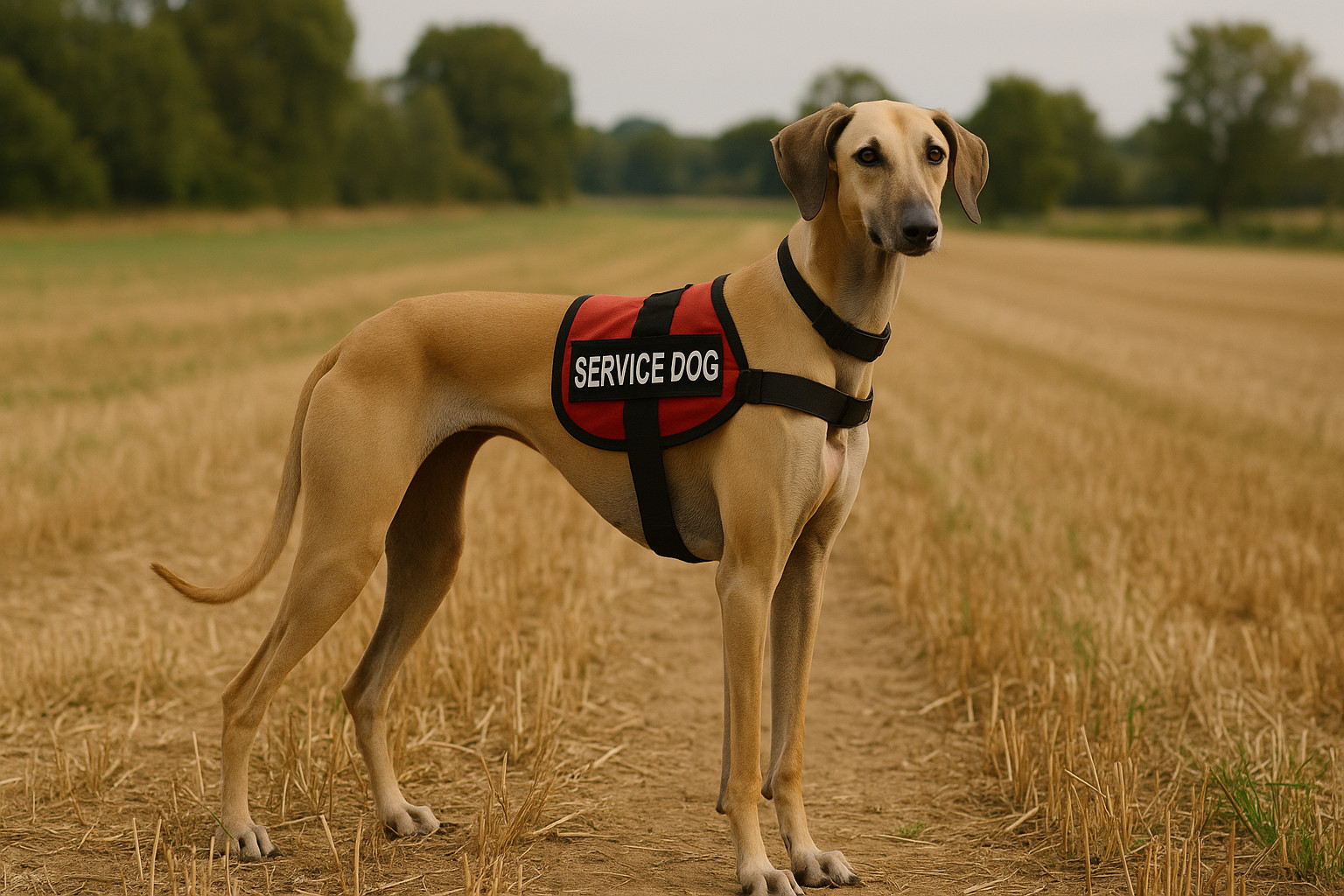Sloughi as a Service Dog
Register Your Dog

Sloughi Overview
The Sloughi, often referred to as the ‘Arabian Greyhound,’ is a breed that traces its origins back to North Africa, particularly Morocco, Tunisia, Libya, and Algeria. Known for their elegance and speed, Sloughis have been historically utilized for hunting game across the expansive desert landscape. With a sleek appearance and a placid temperament, they might initially seem like a viable option for service work. However, when considering this breed for service roles, one must scrutinize its attributes, training capacity, and health considerations to determine suitability.
Physical Characteristics
Sloughis are medium-to-large sized sighthounds distinguished by their lean and muscular build, which is finely tuned for speed and endurance. Physically, they present:
- Height: Usually ranging from 24 to 29 inches at the shoulder.
- Weight: Between 45 and 70 pounds, which strikes a balance between agility and strength.
- Appearance: A sleek body with short, smooth coats that come in various shades of sand, fawn, and brindle. They have a distinctive face with a long, narrow head and large, dark eyes.
- Strength and Agility: While not as robust as some of the larger service breeds, they are agile and fast, making them less suitable for tasks requiring significant physical strength.
These physical attributes impact their overall suitability for service work. While agile and graceful, their lean frames may not be ideal for service tasks that demand substantial strength, such as mobility assistance. However, their agility and speed could potentially serve well in roles that require swift action or light service tasks.
Temperament and Attitude
The temperament and natural instincts of a breed significantly influence their efficacy as service dogs. The Sloughi is known for:
- Reserved Nature: Typically aloof and cautious with strangers, which can be a disadvantage in public service roles.
- Intelligent and Observant: Sloughis are quick to pick up on cues in their environment, though their independence may sometimes overshadow their responsiveness to commands.
- Protective Instincts: Loyal to their family, Sloughis can be protective, which could either be beneficial or distracting in a service capacity.
Owing to their sighthound heritage, Sloughis possess keen observational skills and a strong prey drive, which means they can be easily distracted by movement. This instinct can pose challenges in environments requiring complete focus or in scenarios where sudden reactions to stimuli are not desirable.
Types of Service Work
When assessing the Sloughi for service roles, their sighthound characteristics offer both advantages and limitations:
- Emotional Support Animal (ESA): Sloughis, with their gentle and calm demeanor, may serve well in this role for owners needing companionship and emotional support. Their presence can be soothing, as they tend to bond closely with their owners.
- Psychiatric Services: They can potentially offer assistance in managing conditions like anxiety or PTSD by providing a grounding presence. However, their independent temperament may require focused training and handling.
- Medical Alert: With proper training, they might serve in roles where their keen senses can detect changes in condition, though their instinctual behavior can be a limiting factor.
Sloughis are typically not suitable for roles that demand physical support or mobility assistance due to their lighter frame and more reserved nature. Their independent streak can also make them less apt for tasks where absolute compliance is critical.
Health Considerations
Like any breed considered for service work, the Sloughi’s health profile plays a crucial role:
- Lifespan: Generally, Sloughis live between 10 to 15 years, which is a stable range for service dogs.
- Common Health Issues: They are relatively healthy but may be prone to conditions such as progressive retinal atrophy (PRA), hip dysplasia, and bloat.
- Skin and Coat: Their short coat requires minimal maintenance, but they are sensitive to extreme temperatures, demanding consideration in different climates.
These health factors need to be rigorously monitored as any potential service dog would require regular veterinary checks and a management strategy for breed-specific health issues to ensure they can carry out their duties effectively without risk.
Training and Suitability
Training a Sloughi for service work involves navigating their keen intelligence and independent nature. They have the capacity for learning, yet:
- Trainability: While they can learn commands quickly, their compliance is variable. Training must be consistent, positive, and engaging to maintain their interest and compliance.
- Independence: The Sloughi’s autonomy can make them imaginative problem solvers, yet can also turn them away from execution if not suitably motivated.
- Socialization: Early and thorough socialization is necessary to prevent shyness or excessive wariness toward strangers, especially when they are to function in public roles.
Successful training with Sloughis hinges on building a strong bond with the handler and employing techniques that leverage positive reinforcement rather than coercive methods, which could dampen their effectiveness and well-being.
Summary of Sloughi
In summary, the Sloughi presents a mixed bag of traits that influence its potential viability as a service dog. Their suitability depends largely on:
- Strengths: Agile, gentle temperament, observant, and an effective companion.
- Weaknesses: Not physically robust enough for heavy-duty or strength-based service tasks, can be aloof with strangers, distraction-prone due to prey drive.
- Ideal Service Roles: Emotional Support Animal, possibly Psychiatric Service roles with focused training.
The evaluation of the Sloughi suggests that while they may not fit traditional expectations for a service dog in heavy-duty tasks, they can excel in roles where emotional support and companionship are foremost. Their application must be aligned closely with their core capabilities and characteristics to ensure a prosperous service partnership.











